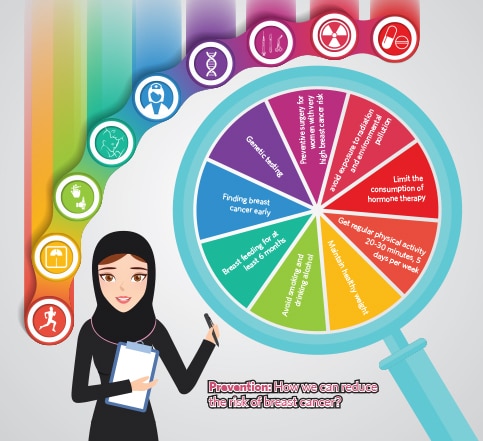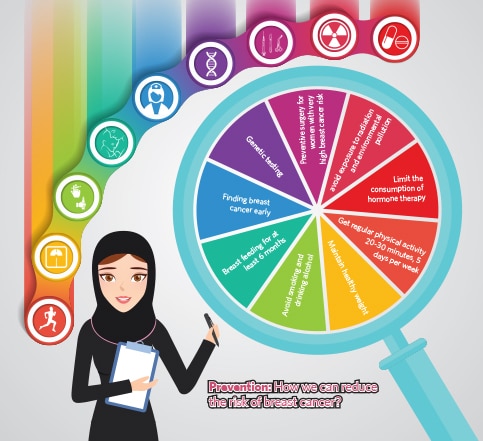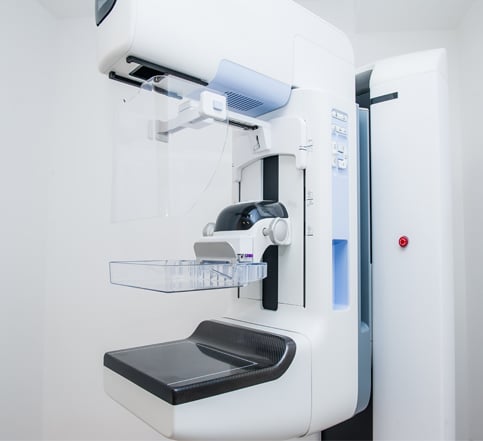Breast Cancer
Breast cancer is Uncontrolled growth of Abnormal cells in the tissues of the breast, which grow and divide more quickly than healthy cells
Non-modifiable risk factors:
- Gender (females are 100 fold more risky than men)
- Age (especially age group of 55 and above)
- Family history of breast cancer (close relative; mother, sister, daughter).
- Past medical history of breast cancer
- About 5% to 10% of breast cancer cases are thought to be hereditary
- Early age at menarche (before age 12) and / or older age at menopause (after age 55).
- Have dense breasts, which mean you have a lot of fibrous or glandular tissue and not much fatty tissue in your breasts. Breast density can be determined through screening (Mammogram)
Non-modifiable risk factors:
- obesity
- Therapeutic & environmental exposures to radiation
- Smoking & drinking alcohol.
- women who do not conceive or have their first child after the age of 30 years
- Women who are not breastfeeding.
- lack of exercise
- a persistent lump in the breast that may feel different from other breast tissue
- One or more lumps in the armpit
- Changes in breast shape or size of breast
- Breast skin changes, such as Redness, dimpling, hotness, visible veins, or itching.
- Nipple pain or changes, such as nipple inversion, scaling, or abnormal discharge.
How we can reduce the risk of breast cancer?
- Get regular physical activity 20-30 minutes, 5 days per week.
- Maintain healthy weight
- Avoid smoking and drinking alcohol
- Breast feeding for at least 6 months
- Finding breast cancer early
- Avoid exposure to radiation and environmental pollution
- Limit the consumption of hormone therapy. (Hormonal contraceptive, female hormonal replacement therapy)

Remember:
Anyone can get breast cancer. But your chances go up as you get older.
Even small breast cancers can be found with a mammogram.
If breast cancer is found when it’s small and before it has spread, it’s easier to treat.
Go for early detection if:
You are 20 years and older start clinical breast exam at the doctor office periodically
You are 45 years and older start mammogram test.
Family history with breast cancer.
Previous lump in your breast (benign or malignant)
Genetic predisposition of getting breast cancer
Mammogram Test
Radiological examination done by doctor, in which the breast compressed between two sheets, where the breast tissue becomes flat and easily photographed. It is painless but may cause a feeling of discomfort during the examination.
Continue to do the test every 3 years.
The doctor will do more instigation to check the final result, keep in mind that 80-85% of the lumps detected are benign) not cancer)
Please don’t hesitate to contact; Breast cancer early detection call center (PHCC). phone number: 8001112


Breast Cancer Statistics – Qatar 2016
- According to the latest Qatar National Cancer Registry (QNCR) – Ministry of Public Health in Qatar, in 2016 there were 266 breast cancer newly diagnosed cases in Qatar.
- 3% of all newly diagnosed cases in 2016 were males and 97% were females.
- 94% of the newly diagnosed cases in 2016 were Qataris and 74.06% were Non-Qataris.
- In 2016, the cumulative risk for women between 0-74 years old is 8.4%, which means almost one out of 12 women will develop breast cancer before 75 years old in Qatar.
- Almost 64% of newly diagnosed cases of breast cancer in Qatar in 2016 were diagnosed in early stages (stage 1 or stage2).
Breast Cancer Statistics –Worldwide 2018
- According to QNCR, from 2013 to 2015 females breast cancer survival rate was 82.3%, while in the period from 2013 to 2016 the survival rate increased to 89.07%, which means that 89.07% of females diagnosed with breast cancer between 2013 and 2016 were still alive up to 2016.
- In 2018, according to the International Agency for Research on Cancer (IARC) – World Health Organization, there were 2 088 849 newly diagnosed women with breast cancer.
- Worldwide, in 2018, the cumulative breast cancer incidence risk for women between 0-74 years old is 5.03%, which means one woman out of 20 will develop breast cancer before 75 years old.
- Worldwide, in 2018 the cumulative breast cancer mortality risk for women between 0-79 years old is 1.8, which means one woman out of 56 will die due to breast cancer before 80 years old.
- Worldwide, between 2014 and 2018, there were 6875099 women diagnosed with breast cancer.
- + Risk factors
-
Non-modifiable risk factors:
- Gender (females are 100 fold more risky than men)
- Age (especially age group of 55 and above)
- Family history of breast cancer (close relative; mother, sister, daughter).
- Past medical history of breast cancer
- About 5% to 10% of breast cancer cases are thought to be hereditary
- Early age at menarche (before age 12) and / or older age at menopause (after age 55).
- Have dense breasts, which mean you have a lot of fibrous or glandular tissue and not much fatty tissue in your breasts. Breast density can be determined through screening (Mammogram)
Non-modifiable risk factors:
- obesity
- Therapeutic & environmental exposures to radiation
- Smoking & drinking alcohol.
- women who do not conceive or have their first child after the age of 30 years
- Women who are not breastfeeding.
- lack of exercise
- + Symptoms and warning signs
-
- a persistent lump in the breast that may feel different from other breast tissue
- One or more lumps in the armpit
- Changes in breast shape or size of breast
- Breast skin changes, such as Redness, dimpling, hotness, visible veins, or itching.
- Nipple pain or changes, such as nipple inversion, scaling, or abnormal discharge.
- + Prevention
-
How we can reduce the risk of breast cancer?
- Get regular physical activity 20-30 minutes, 5 days per week.
- Maintain healthy weight
- Avoid smoking and drinking alcohol
- Breast feeding for at least 6 months
- Finding breast cancer early
- Avoid exposure to radiation and environmental pollution
- Limit the consumption of hormone therapy. (Hormonal contraceptive, female hormonal replacement therapy)

- + Screening
-
Remember:
Anyone can get breast cancer. But your chances go up as you get older.
Even small breast cancers can be found with a mammogram.
If breast cancer is found when it’s small and before it has spread, it’s easier to treat.
Go for early detection if:
You are 20 years and older start clinical breast exam at the doctor office periodically
You are 45 years and older start mammogram test.
Family history with breast cancer.
Previous lump in your breast (benign or malignant)
Genetic predisposition of getting breast cancer
Mammogram Test
Radiological examination done by doctor, in which the breast compressed between two sheets, where the breast tissue becomes flat and easily photographed. It is painless but may cause a feeling of discomfort during the examination.
Continue to do the test every 3 years.
The doctor will do more instigation to check the final result, keep in mind that 80-85% of the lumps detected are benign) not cancer)
Please don’t hesitate to contact; Breast cancer early detection call center (PHCC). phone number: 8001112


What is a mammogram الماموجرام - + Statistics
-
Breast Cancer Statistics – Qatar 2016
- According to the latest Qatar National Cancer Registry (QNCR) – Ministry of Public Health in Qatar, in 2016 there were 266 breast cancer newly diagnosed cases in Qatar.
- 3% of all newly diagnosed cases in 2016 were males and 97% were females.
- 94% of the newly diagnosed cases in 2016 were Qataris and 74.06% were Non-Qataris.
- In 2016, the cumulative risk for women between 0-74 years old is 8.4%, which means almost one out of 12 women will develop breast cancer before 75 years old in Qatar.
- Almost 64% of newly diagnosed cases of breast cancer in Qatar in 2016 were diagnosed in early stages (stage 1 or stage2).
Breast Cancer Statistics –Worldwide 2018
- According to QNCR, from 2013 to 2015 females breast cancer survival rate was 82.3%, while in the period from 2013 to 2016 the survival rate increased to 89.07%, which means that 89.07% of females diagnosed with breast cancer between 2013 and 2016 were still alive up to 2016.
- In 2018, according to the International Agency for Research on Cancer (IARC) – World Health Organization, there were 2 088 849 newly diagnosed women with breast cancer.
- Worldwide, in 2018, the cumulative breast cancer incidence risk for women between 0-74 years old is 5.03%, which means one woman out of 20 will develop breast cancer before 75 years old.
- Worldwide, in 2018 the cumulative breast cancer mortality risk for women between 0-79 years old is 1.8, which means one woman out of 56 will die due to breast cancer before 80 years old.
- Worldwide, between 2014 and 2018, there were 6875099 women diagnosed with breast cancer.
